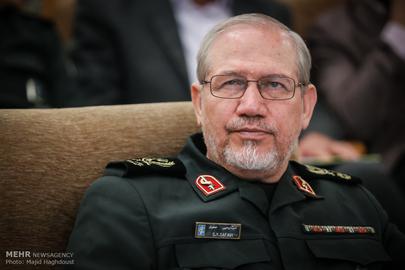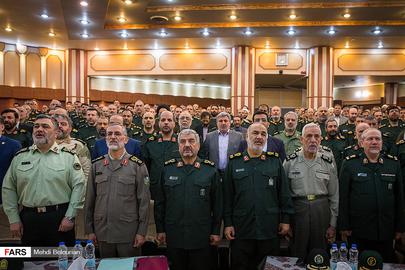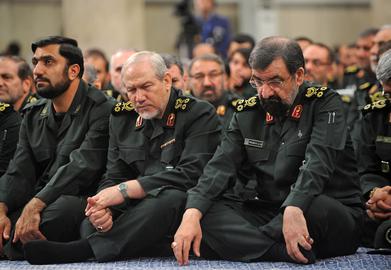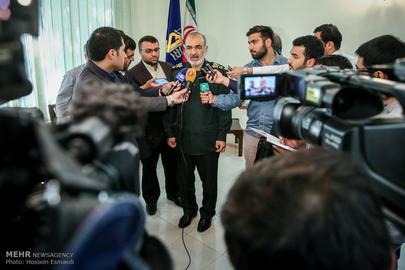The principal stage managers of the sprawling Revolutionary Guards organization are its generals and commanders. Each plays a leading role in one of the affiliate entities in this endless labyrinth. What do we know about them? Where do they come from? What is their record? Where do they stand? What are their positions? What do we know about their personal lives?
In this series, we have tried to look into the lives of the most important Revolutionary Guards’ commanders — before they joined the Guards, when they did and where they stand now.
Yahya “Rahim” Safavi was the fifth Revolutionary Guards Chief Commander and the first one to be appointed by Ayatollah Khamenei. He earned the nickname “Rahim” as a young protester before the 1979 revolution and the name has stuck throughout his life.
He was born in the small village of Hamam in Isfahan province. In 1971, he was admitted to Tabriz University’s geology program, where by his own telling, he started his political activism against the Shah’s regime. After graduation, he served a period of mandatory military service before he returned to Tabriz. There, he resumed his protests against the government, during which time he was shot and had to flee the country, leaving for Syria and then Lebanon. The Shah’s intelligence agents regarded him as a wanted man, but fortunately for him, his brother helped him to secure a passport and a safe exit out of Iran.
In Syria, he met with Ali Jannati and Mohammad Gharazi, the future Minister of Communications during Ali Akbar Hashemi Rafsanjani’s administration. Later, he journeyed to southern Lebanon to partake in military training. Beyond his previous army training in Iran, he also claimed to have spent several months in Qom Seminary.
His brother, Salman “Ghahreman” Safavi, a future Revolutionary Guards (IRGC) officer, had studied at Qom Seminary as well. While Rahim was out of the country, his brother participated in armed fights against the Shah. Salman was the one who sent his brother out of the country and put him in touch with Mohammad Montazeri and Mohammad Gharazi in the south of Lebanon.
Unlike his brother, Salman was a fan of Ayatollah Montazeri. For a short period, he was the deputy chief of the London Islamic Center and head of the Iran Studies Academy in London. He also ran for office in the eighth congressional election as a National Trust Party candidate, but he lost the election.
When Rahim Safavi proposed to his future wife, a fellow Guards officer, she confronted her future husband with 15 written questions, including enquiries into his views on the Peoples’ Mojahedin of Iran Organization (MEK) and the Freedom Movement of Iran.
Later, Safavi left Lebanon for Neauphle-le-Château, a commune in France where Ayatollah Khomeini was residing. While there, he networked with a number of active revolutionaries who encouraged him to return to Iran and carry out their instructions. He later recalled that Ali Jannati filled his car with weapons and ammunition before he was smuggled back into the country.
Shortly after the revolution, Safavi was appointed Commander of the Revolutionary Guards' Operations in Isfahan. Since the first days of the revolution, the IRGC found itself in constant conflict with the Revolution Committees. Safavi, IRGC affiliates, and colleagues including Mohammad Atrianfar and Ahmad Salek, were leftists, while the Committees consisted of a number of right-wing conservatives. There were even instances of armed conflicts between the factions. Isfahan’s governor at the time, Kazem Mousavi-Bojnourdi, described a meeting at his residence where they had decided to attack the Committees’ offices with grenades. But Hassan Sanei of Ayatollah Khomeini’s office intervened and ordered them to stand down and avoid escalating the conflict. Today, Safavi likes to distance himself from his early leftist colleagues like Ayatollah Taheri and Gholam-Hossein Karbaschi, claiming that he always held strong disagreements with them.
Suppressing Unrest
Safavi was deployed in late 1979 alongside Mostafa Charman and Ali Sayad-Shirazi to suppress unrest in Iranian Kurdistan, where Kurdish militias had rebelled against the interim Iranian government. There, Safavi served as commander of IRGC Operations until the beginning of the Iran-Iraq War, which began in 1988.
When hostilities began between Iran and Iraq, the IRGC Deputy Commander, Yusof Kolahduz, invited Safavi to the IRGC’s Southern Command Center. There he met Hossein Kharazi, who would later be appointed as Commander of the 14th Army of Imam Hussein. Safavi was soon appointed as IRGC Operations Commander of the South and later the IRGC Ground Forces Commander.
In 2014, Ali Akbar Hashemi Rafsanjani stated that after losing the Al-Faw Peninsula, some Iranian officials entertained the idea of prosecuting and executing various IRGC Commanders — including Rahim Safavi. “He left Al-Faw behind with all the facilities and equipment we had there. He fled across the bridge that we had earned with our blood, and he left it for the enemy,” Rafsanjani said.
Later, another IRGC high-ranked commander, Ahmad Gholami, spoke about the Al-Faw defeat in an interview. “When we lost Al-Faw, I was the commander of Karbala Command Center in the south and Al-Faw was also under my command. We established a strategic headquarters in the peninsula commanded by Reza Seifallahi. If anyone was to be executed for losing the peninsula it should have been me, or perhaps more broadly, Commander-in-Chief Mohsen Rezaei should have been prosecuted, as the war effort’s ultimate commander.”
In 1997, when Mohsen Rezaei was leaving the force, he recommended Ali Shamkhani and Gholam Ali Rashid as potential candidates to replace him. Despite the recommendations, Ayatollah Khamenei appointed Rahim Safavi, then IRGC Deputy Commander, to this position. According to Rezaei, other IRGC Commanders recommended Safavi to the Supreme Leader.
Safavi’s tenure as Commander-in-Chief coincided with the reformist administration of Mohammad Khatami and a number of important events in Iranian politics. Some IRGC commanders were dismissed and replaced. Important appointments of the new era included Ghasem Soleimani as the Quds Force Commander, Mohammad Bagher Ghalibaf as Air Force Commander, and Ahmad Kazemi as Ground Forces Commander.
After the 1997 presidential election, Safavi delivered a controversial speech that earned widespread attention. “This election has enabled the venomous snakes to come out of their dark holes. But they should know that we’ll cut the snakes’ heads, and for some snakes, their tongues.”
During Safavi’s command, the Basij Organization gained enormous power and influence. Another important event was the suppression of student protests in 1999, during which the IRGC raided Tehran University’s dormitory. By Safavi’s account, President Mohammad Khatami and his Interior Minister had refused to allow the IRGC to intervene, but he protested vigorously and eventually secured the blessing of Hassan Rouhani and the Supreme Leader, green-lighting the IRGC’s crackdown on the students within hours.
Unlike Rezaei’s period of command, which seemed permanent and only ended with his own resignation, Rahim Safavi’s tenure lasted 10 years, like most other Khamenei appointees' terms of service. After his time as Commander, he was appointed as special counsel for the Supreme Leader, where he continues to be known for making controversial statements.
Also in this series:
Ghasem Soleimani: The Mythical Commander
visit the accountability section
In this section of Iran Wire, you can contact the officials and launch your campaign for various problems



























comments